The Components of Healing
Start with the basics known for healing after a brain injury. Eat well, sleep well, exercise and have an active mind.
An active mind is actually a mind that has heightened awareness as well as frequent, frenetic, factual executive functioning episodes.
Additionally, some traits of the survivor should be nurtured from the earliest stages. These include curiosity and flexibility as well as consideration for others. Curiosity to get the mind engaged and sustained in any number of thought processes. Flexibility to work around any particular deficit to see alternative ways to approach the need at hand. For example, if the person has trouble tying their shoes at first perhaps a Velcro pair are easier to manage.
“An active mind is actually a mind that has heightened awareness as well as frequent, frenetic, factual executive functioning episodes.”
At first it is necessary to have some interaction with others. One is not aware of too much in the early stages of recovery from a serious accident. The process to relearn the basics is very individual and time consuming. While most these sorts of activities will return in a matter of months – it should be remembered that each survivor is different. These basic tasks or skills set the stage for further development of the remaining cognitive skills of the survivor.
At this stage the professionals are all about the ‘getting back to work process’. If we were to skip this emphasis and go to the actual restoration of the whole person then we would have a much more humane process on our hands.
If we proceed from getting oriented to our new bodies and minds by using the normal activities of daily living as a guide then we may progress further, to the point where the survivor is facilitated to start their own rehabilitation process. Each person starts on this journey of self-directed therapy in a unique way – indeed some may never come to this point.




